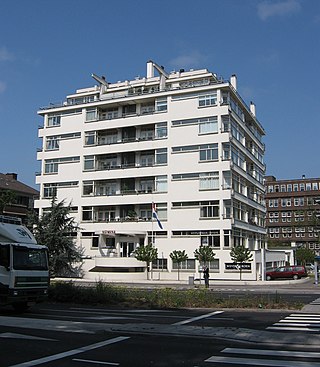Related Research Articles

Wisma 46 is a 261.9-meter tall skyscraper located in the BNI City complex at Jalan Jenderal Sudirman in Jakarta, Indonesia. The 46-floor office tower features a 10 m (33 ft) antenna spire, and was completed in 1996 under the design by Zeidler Roberts Partnership and DP Architects Private Ltd.

Villa Isola is an art-deco building in the northern part of Bandung, the capital of West Java province of Indonesia. Overlooking the valley with the view of the city, Villa Isola was completed in 1933 by the Dutch architect Wolff Schoemaker for the Dutch media tycoon Dominique Willem Berretty, the founder of the Aneta press-agency in the Dutch East Indies. The original purpose of the building was for Berretty's private house, but then it was transformed into a hotel after his death and now it serves as the rectorate building of Indonesia University of Education.

The architecture of Indonesia reflects the diversity of cultural, historical, and geographic influences that have shaped Indonesia as a whole. Invaders, colonizers, missionaries, merchants, and traders brought cultural changes that had a profound effect on building styles and techniques.

Nieuwe Zakelijkheid, translated as New Objectivity or New Pragmatism, is a Dutch period of modernist architecture that started in the 1920s and continued into the 1930s. The term is also used to denote a (brief) period in art and literature. Related to and descended from the German movement Neue Sachlichkeit, Nieuwe Zakelijkheid is characterized by angular shapes and designs that are generally free of ornamentation and decoration. The architecture is based on functional considerations and often includes open layouts that allow spaces to be used with flexibility. Sliding doors were included in some of the designs.

Charles Prosper Wolff Schoemaker was a Dutch architect who designed several distinguished Art Deco buildings in Bandung, Indonesia, including the Villa Isola and Hotel Preanger. He has been described as "the Frank Lloyd Wright of Indonesia," and Wright had a considerable influence on Wolff Schoemaker's modernist designs. Although he was primarily known as an architect, he was also a painter and sculptor.

Jengki, also known as Yankee style, was a post-war modernist architectural style developed in Indonesia following its independence. The style was popular between late 1950s and early 1960s.

A landhuis is a Dutch colonial country house, often the administrative heart of a particuliere land or private domain in the Dutch East Indies, now Indonesia. Many country houses were built by the Dutch in other colonial settlements, such as Galle, Cape Town and Curaçao, but none as extensively or elaborately as in the Residency of Batavia. Much of Batavia's reputation as "Queen of the East" rested on the grandeur of these 18th-century mansions.

New Indies Style is a modern architectural style used in the Dutch East Indies between the late 19th century through pre-World War II 20th century. New Indies Style is basically early modern (western) architecture, which applies local architectural elements such as wide eaves or prominent roof as an attempt to conform with the tropical climate of Indonesia.

The Kologdam Building is a historic building in Bandung, Indonesia. In the 1920s, Kologdam Building was the main building for the Bandung Jaarbeurs, a complex of buildings and pavilions where annual trade was held. The building is currently a military complex for the Education and Training Command Headquarters of the Siliwangi Division.

Cirebon City Hall is a city hall in Cirebon City, West Java, Indonesia. The building shows implementation of the Dutch Amsterdam School Style in the colonial Dutch East Indies, now Indonesia.
Liem Bwan Tjie was a prominent architect, and a pioneering figure of modern Indonesian architecture. He belonged to the first generation of professionally trained Indonesian architects.

Semarang Poncol Station (SMC) is a historic railway station in Purwosari, North Semarang, Semarang, Indonesia. The station which is located at an altitude of +3 meters is included in the Semarang Operational Area IV and is the second main station in Semarang after Semarang Tawang Station. It was built in 1914 and is considered an early example of Art Deco architecture.

Javanese traditional house refers to the traditional vernacular houses of Javanese people in the island of Java, Indonesia.

Indies Empire style is an architectural style that flourished in the colonial Dutch East Indies between the middle of the 18th century and the end of the 19th century. The style is an imitation of the neoclassical Empire Style which was popular in mid-19th-century France. Conformed to the tropical setting of Indonesia, the style became known in the Dutch East Indies as the Indies Empire style.

The Great Mosque of Sumenep is an 18th-century mosque in Sumenep, Madura. Standing on the alun-alun of Sumenep, it is the largest mosque on Madura Island and a noted landmark of Madura.

Johannes Martinus (Han) Groenewegen was a Dutch architect who was active in the Netherlands and the Dutch East Indies, and subsequently, Indonesia from the 1920s to the 1960s.
Soejoedi Wirjoatmodjo was an architect in Indonesia who was active during the late 1960s and mid-1970s. In 1964, he was asked by President Sukarno to be the chief architect for national architectural projects in Jakarta. Soejoedi is considered the first native architect of the Post-Colonial period and is considered a proponent of modernist architects and designers.

Friedrich Silaban was an Indonesian architect. His most well-known designs, such as the Istiqlal Mosque and the Gelora Bung Karno Sports Complex, in particular the Main Stadium in Jakarta, were commissioned during the presidency of Sukarno. Silaban preferred architectural modernism over traditional Indonesian styles.
References
- ↑ Het Indische bouwen: architectuur en stedebouw in Indonesie : Dutch and Indisch architecture 1800-1950. Helmond: Gemeentemuseum Helmond. 1990. pp. 28–31. Retrieved March 30, 2015.
- ↑ "Arsitek-arsitek Indonesia yang Berjaya di Luar Negeri Halaman all". 5 March 2019.
- ↑ "Arsitek Muda Indonesia: Media, Sebelum Arsitektur - Arsitektur Indonesia".